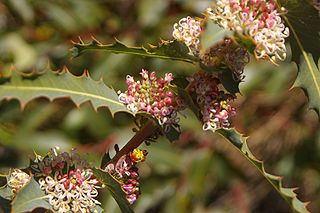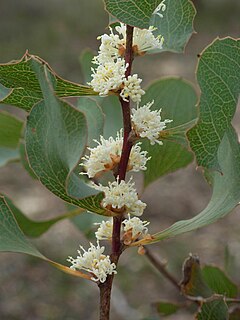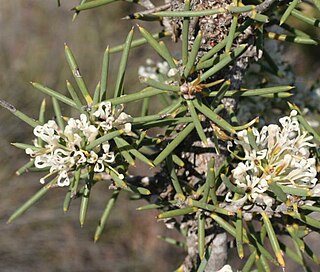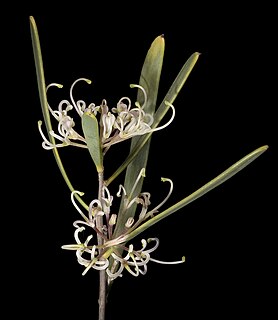
Hakea bucculenta, commonly known as red pokers, is a large shrub in the family Proteaceae endemic to Western Australia. A spectacular ornamental shrub with red or orange flowers that appear in rod-like blooms in leaf axils for an extended period from May to November.

Hakea scoparia is a species of flowering plant in the family Proteaceae and is endemic to the south-west of Western Australia where it grows in shrubland. It is a shrub with ascending branches, terete leaves and clusters of cream to pinkish flowers in leaf axils from June to September.

Hakea corymbosa, commonly known as the cauliflower hakea is a plant of the family Proteaceae which is endemic to the south-west of Western Australia. An attractive extremely prickly bush with sweetly scented yellowish flowers. The nectar rich blooms and dense form provides a good habitat for wildlife.

Hakea amplexicaulis, commonly known as prickly hakea, is a shrub endemic to south west Western Australia. An attractive small shrub with unusual stem clasping, sharply serrated foliage and a profusion of sweetly scented variable coloured flowers from late winter to spring.

Dampiera stricta commonly known as blue dampiera, is a flowering plant in the family Goodeniaceae. It is a small sub-shrub with variable leaves and mostly blue, mauve or purple flowers.

Hakea trifurcata, commonly known as two-leaf, two-leaved hakea, or kerosene bush, is a shrub, endemic to the south-west of Western Australia. The species has two leaf forms, needle-like or oblong egg-shaped. Unlike most hakea species the fruit remain green at maturity and resemble the broader leaf form. The mimicry creates a camouflage, reducing predation of the seed by granivores in particular cockatoos.

Hakea undulata, commonly known as wavy-leaved hakea, is a flowering plant in the family Proteaceae and is endemic to the south-west of Western Australia. It has stiff wavy leaves and fragrant cream-white flowers from mid-winter to October.

Hakea denticulata, commonly known as stinking Roger is a shrub tree endemic southern Western Australia. One of the many species of Australian plant described by the botanist Robert Brown. A compact shrub 1–2 m (3–7 ft) high and wide with red flowers in the spring with an unpleasant odour.

Hakea chordophylla, commonly known as bootlace oak, bootlace tree, corkwood, or bull oak, is a species of shrub or small tree in the family Proteaceae found in central and northern Australia. Bares very showy golden yellow, pale green or cream nectar rich flowers in winter.

Hakea cristata, commonly known as the snail hakea, is a shrub in the family Proteaceae native to Western Australia. An ornamental prickly shrub with attractive foliage and creamy white rounded flowers appearing in profusion in the winter months.

Hakea cucullata, commonly known as hood-leaved hakea, cup hakea or scallop hakea, is a species of shrub in the family Proteaceae and is endemic to the south-west of Western Australia. An attractive shrub with unusual distinctive foliage and beautiful large pink, red or deep purple scented flowers.

Haemodorum brevicaule is a perennial herb from 0.025 to 0.3 m tall, in the bloodroot family, the Haemodoraceae, native to northern Australia. It has deep-red to purplish-black flowers which are seen from September to December, and it grows on red clay and basalt.

Hakea adnata is a shrub in the family Proteaceae native to the south coast of Western Australia. It is multi-stemmed shrub that produces masses of white scented flowers from late winter to spring.

Hakea ambigua is a shrub in the family Proteaceae. In favourable conditions may grow into an attractive weeping shrub with creamy white flowers. Only found in the Stirling Ranges of southern Western Australia.

Hakea elliptica, commonly known as the oval-leaf hakea, is a shrub in the family Proteacea and is endemic to Western Australia. A fast growing adaptable species with ornamental wavy leaves, golden bronze new growth and an abundance of showy white flowers. A good wildlife habitat due to its dense form with foliage to ground level.
Hakea tuberculata is a flowering plant in the family Proteaceae and is endemic to several isolated areas along the coast in the Peel, South West, Great Southern and Goldfields-Esperance regions of Western Australia. It is an upright shrub with white flowers and rigid, prickly leaves.

Hakea obliqua, commonly known as needles and corks, is a shrub in the family Proteaceae and is endemic to an area in the Wheatbelt, Great Southern and Goldfields-Esperance regions of Western Australia.

Hakea psilorrhyncha is a flowering plant in the family Proteacea, it is endemic to a small area on the west coast in the Wheatbelt and Mid West regions of Western Australia. It has needle-shaped, sharply pointed leaves and clusters of scented brownish yellow flowers.

Hakea recurva, commonly known as jarnockmert, is a flowering shrub or small tree in the family Proteaceae and is endemic to an area in the Mid West, northern Wheatbelt and the Goldfields-Esperance regions of Western Australia. It has creams-white to yellow flowers and thick, prickly, curved leaves.

Hakea stenophylla is a shrub or tree in the family Proteacea, with sweetly scented creamy-white flowers. It is endemic to Western Australia.



















